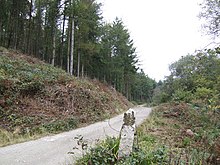
Arrallas (also Argallez, Argalles) was a manorial settlement recorded in the Domesday book, when in 1086 it had seven households and three ploughlands. It is located in the parish of St Enoder in Cornwall, England. Its name derives from the Cornish language words arghans and lys meaning "silver court", with the lys likely denoting a site of royal importance.
In the fourth year of the reign of Edward I (c. 1276) a jury in the Hundred of Powdershire held that Robert de Cardinan had held the fee in chief of Henry III, but this was alienated by Isolda de Cardinan and was then now held by a Mauger de St. Albin. When a Guy St Aubyn's widow Alice Sergeaux married Richard de Vere, 11th Earl of Oxford it passed to the earl, before returning to the St Aubyn family. In the fifteenth century becoming vested in the crown it was granted to George Plantagenet, 1st Duke of Clarence c. 1462. In 1492 the manor was granted to John de Vere, 13th Earl of Oxford, who forfeited it and whence it came to the Duke of Gloucester. It later passed to the Vyvyan baronets and Rashleigh family.
Arrallas Farm is now part of the 2,215 acre Arrallas Estate acquired by the Duchy of Cornwall in 1952. The 18th century farmhouse is a Grade II listed building, as is a range of associated farm buildings.
References
- "Arrallas". opendomesday.org. Retrieved 12 January 2020.
- Daniel Lysons; Samuel Lysons (1814). "Parishes: Egloshayle - St Ewe". Magna Britannia: Volume 3, Cornwall. pp. 81–98.
- "History of St Enoder Parish". St Enoder Parish Council. Retrieved 12 January 2020.
- Padel, Oliver J. (1985), "Cornish Place-Name Elements", The Survey of English Place-Names, 56–57, English Place-Name Society, University of Nottingham, ISBN 0904889114
- George Concanen (1830). "Appendix to the case of Rowe v. Brenton". A Report of the Trial at Bar, Rowe v. Brenton, Tried in The Court of King's Bench, Westminster, Michaelmas Term, 9 Geo. IV. as to the Right to Minerals in the Assessional Lands of the Duchy of Cornwall with Explanatory Notes; and an Appendix Containing the Records and Documents as Given in Evidence. W. Walker, 196 Strand.
- Arthur Collins (1741). The English Baronetage Volume III Part II. Tho. Wotton, at the Three Daggers and Queen's Head, against St. Dunstan's Church, in Fleet-Street. p. 544.
- ^ Joseph Polsue (1867). A Complete Parochial History of the County of Cornwall, Volume 1. p. 341.
- Account roll Poldu, Rosneython, Trenynnek, Argalles, Penhale, Predannek, Ethron ... (Catalogue description), The National Archives (United Kingdom), AR/2/843,
These manors were all granted to the Earl of Oxford in 1492 (AR/1/995/3)...
- Parliament, Great Britain; Pridden, John (1832). Index to the Rolls of Parliament. Vol. From Ann. 6 Edw I to Ann. 19 Hen VII (A.D. 1278 - 1503 A.D.). p. 33.
- "Farm tenancy with Duchy of Cornwall opens to applications". Farmers Weekly. 28 January 2016. Retrieved 12 January 2020.
- "History of the Duchy". Duchy of Cornwall. Retrieved 12 January 2020.
- Historic England. "Arallas Farmhouse (1138347)". National Heritage List for England. Retrieved 12 January 2020.
- Historic England. "Range of farm buildings about 100 - metres south east of Arrallas Farmhouse (1144086)". National Heritage List for England. Retrieved 12 January 2020.
50°20′51″N 4°58′43″W / 50.3476°N 4.9786°W / 50.3476; -4.9786
Categories: